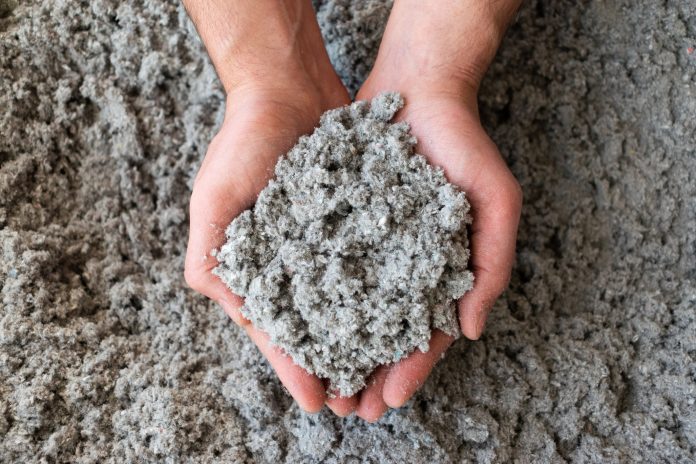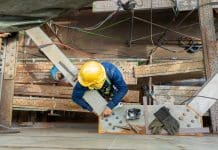For many years, a new, ecological, extremely effective and cheap method for the insulation of attics has existed and is steadily growing in new markets: blown-in cellulose wool
Did you know that in many countries in Europe and across North America the installation of traditional insulation in batts has passed its sell-by date?
Cellulose wool does not come in batts or sections, but is rather blown in with the aid of special machines that break up and then blow in the material.
Thanks to this, fine cellulose wool – which does not contain any hazardous needles, only a fine cellulose ‘down’ seamlessly fills even the tightest, and most irregular spaces, getting into all the nooks and crannies, and guaranteeing a perfect warming effect, eliminating even the smallest of thermal bridges.
Thermal bridges are the biggest cause for heat loss in buildings
Thermal bridges are the biggest reason for the loss of heat in a building and can greatly reduce the efficiency of insulation. Cellulose wool is the best material for non-invasive repair of incorrectly installed insulation – you will see more about this in the following pages.
The U-factor/lambda value for the heat conductivity of pitched roofs is 0.038 W/mK; however, in practice and thanks to the method of installation, the warming effect can be achieved much better with cellulose wool than with other materials of the same ‘lambda’ value.
Cellulose wool is also used for the warming of floors and enclosed spaces like partition and stud walls. The material is blown in under pressure, which also ensures perfect soundproofing of the space. There are not many materials that can match the great acoustic properties of cellulose fibre whilst maintaining the breathability of the material.
The acoustic propertiesw=1,00 is achieved with just 10cm of material. In comparison, the same effect may need up to 20-30cm of other types of insulation.
Cellulose wool insulation breathes and repels moisture
What is more, cellulose wool perfectly breathes and repels moisture, thanks to which it runs no risk of growth of mould and rot, such as in the case of leaks in the roof structure. Resistance to mould growth and damp is also accredited by vigorous tests and in our certification, which cannot be assured as in the case of glass wool.
In the above photographs, you can see how seamlessly Termex ‘Cellulose’ fills a wide variety of construction spaces. Our installer service also includes the construction of an attic floor extension if loft is to be used for storage.
In such cases, we recommend a minimum of 250mm of cellulose insulation to be blown below the attic floor in order to comply with the current regulations (2023). What is more, it does not shrink over time, and, in addition to this, it also prevents the overheating of buildings during hot, dry summers.
The restoration of old or incorrectly installed insulation does not necessarily require the removal of ceilings
Did you know that cellulose is an insulation material which allows the completion of non-invasive repair to thermally insulated roofs across a wide range of applications. Besides this, it is well suited to the soundproofing of walls and ceilings.
During the repair of insulation, our installer makes use of a set of tools – nozzles and lances – which allow access to any space requiring insulation. This installation method can be used in confined cavities, provided that the boarding structure is strong enough to withstand the air pressure.
In cold seasons the installer can also use a thermal camera which serves to discover thermal bridges in relation to different temperatures inside and outside the building.
Cellulose wool is very fine and can seamlessly fill all spaces, even the tightest and hardest to access.
In addition to this, cellulose eliminates damp and even draws it out of old insulation, at the same time as sealing it. Most importantly, the roof structure is able to maintain correct ventilation – so cellulose wool really takes care of eliminating mould.
Installation and repair is a process that does not demand a great deal of time nor the dismantling of ceilings. We make use of professional solutions, which help to remove any defects in existing insulation as well as guaranteeing the correct sealing of newly erected buildings.
In order to carry out repairs, our installer makes a hole in plasterboard from 4-6cm.
Next material is blown in under pressure using a special nozzle… and that’s it!
Several centimetres of compacted cellulose layers guarantee a warm and cosy space.
In the case of lofts used for storage, we can also offer to add extra insulation between the rafters by creating a technical cavity with a dedicated intelligent vapour barrier called Intello, provided by a high-end German manufacturer of specialist air-tightness systems – Proclima.
Specialised insulation of roofs and retrofitting
Did you know that cellulose wool has been used for over 25 years in Poland to insulate
roofs in tower blocks? Yes, absolutely! Roof spaces, sometimes also known as pigeon lofts, are a type of space between the ceiling on the top floor and the roof covered with roofing
felt.
This is usually quite a tight space of between 20 to 80cm in which it is not possible to roll out typical insulation vapour barriers or batts of mineral wool.
That is why the one and only sensible option for the insulation of such roof spaces is with blown-in material, which drives out moisture very well and can be installed under pressure, this entails the exact filling of the entire space.
In Poland, cellulose wool grew to become the (unwritten) market leader in housing co-operatives and multi-occupancy buildings until the time when the method of blowing in material became the most common way to insulate the majority of housing.
At present, cellulose wool is taking a larger share of the single-dwelling housing and retrofit market as a perfect alternative to foam insulation (PUR).
What is also essential is that cellulose is the best option where traditional methods of insulation are unable to cope with pest damage. An example of such applications is the cases of repairing insulation which has been destroyed or damaged by rodents, moisture or excessive heat during summertime.
Termex provide air-tight insulation solutions
Our installers replace specialist pest control firms in carrying out such types of repair, which can be done non-invasively and without the need for the costly refurbishment of the entire roof space. This type of operation can be carried out in very small openings or holes as
detailed earlier.
We provide airtight insulation solutions to create a so-called ‚warm attic space in your loft. Our solution is based on Proclima Intello, a renowned intelligent vapour barrier made in Germany, which allows it to breathe out the excess of moisture in the summertime. Our services include also similar solutions in the attic floor by means of a vapour-permeable membrane.
Altogether an insulated attic floor and roof solution is much better than loft insulation only
because it effectively shuts off any possible drafts and also significantly reduces heat loss in a room-in-roof type of loft. Apart from floor insulation, we also can offer the extension of insulation thickness by installing floorboards up to 200mm above joists.

















